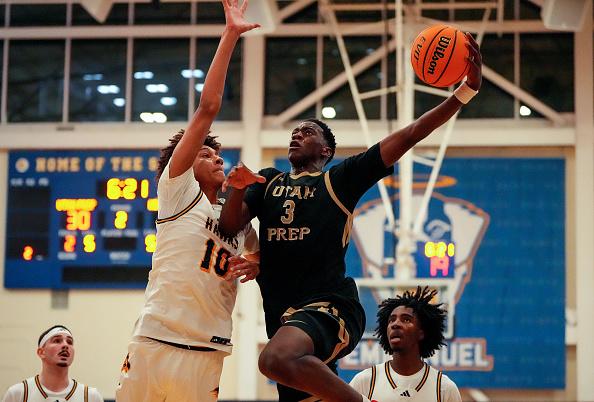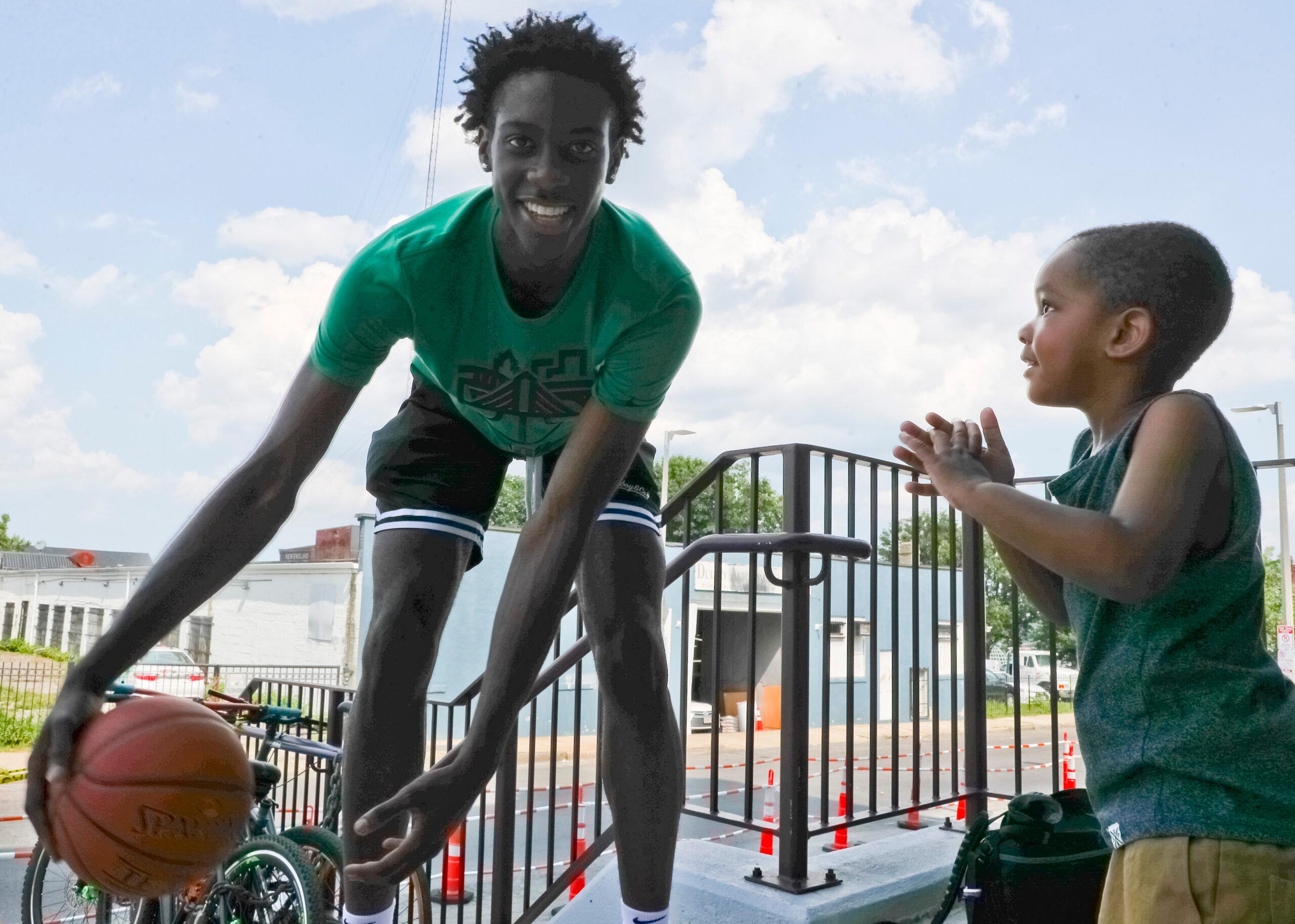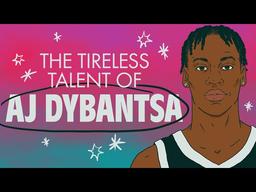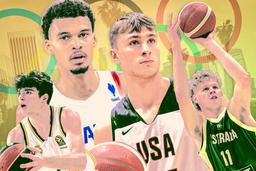AJ Dybantsa tracks the arc of the shot through the air, leaping in celebration as it swishes through the net, swinging his arms and pumping his knees as high as they go. No sooner than he lands, he’s up again, jumping in a mob with everyone around him.
This was not a game-winning shot for his BYU Cougars at the Marriott Center in Provo, Utah. Instead, this is the gymnasium at West Middle School in Brockton, Massachusetts, and what has just ended was not a real basketball game but a game of knockout in which Dybantsa did not even participate.
The 18-year-old, ranked by ESPN as college basketball’s top freshman this season and one of the leading candidates to be selected first in the 2026 NBA draft, is back home for the second edition of his annual backpack giveaway. It’s late August, and the gym is packed with kids, the first of whom started lining up two and a half hours early. Throughout the event, Dybantsa is everywhere: taking pictures, signing autographs, picking songs at the DJ booth, handing out backpacks, hanging with friends. And yes, he is highly invested in the knockout games.
“That’s real enthusiasm,” says Mike Bassett, who works for the global aid group World Vision. He would know. When Bassett is not directing emergency supplies to disaster zones, he coordinates celebrity giveaways. World Vision sources the goods—in this case, packs filled with school supplies, giant boxes of Legos, and 25 brand new bikes—and partners with celebrities and influencers on events. Bassett has worked with about two dozen such headliners and says that he’s rarely seen anybody have as much fun as Dybantsa.
“He’s definitely one of the most engaged,” Bassett says.
All of which is to say that Dybantsa loves his hometown of Brockton, and Brockton loves him back. Dybantsa’s love does not stop at the city limits: He held a similar event two days earlier, about 20 miles up the road in Boston’s Mattapan neighborhood (with similar enthusiasm, Bassett reports). Ever since people started sticking recorders and microphones in his face, Dybantsa has rarely missed a chance—in the most time-honored of Masshole traditions—to declare the greatness of the place he comes from.
“Stop sleeping on Massachusetts we can compete with the best of the best,” Dybantsa wrote in 2021, when he was just 14 and penning a Diary of a Baller blog.
“I’m just a kid from Brockton,” he told The Athletic in 2023, echoing LeBron James’s famous self-description as he was rising nationally.
I just do it because I love where I’m from. Like, yes, that’s in the back of my head. I want people to get noticed. But I’m just doing it because I’m from there.AJ Dybantsa
“My goal is to put Brockton on the map,” he declared to Boston’s CBS news station a year ago.
And when his high-flying squad from Utah Prep—a basketball academy with NIL cash to burn—barnstormed into Boston for a game last season, he told The Boston Globe, “Everybody talks about the New Yorks of the world, the Calis of the world. But Mass. got some hoopers.”
When Dybantsa’s seventh-ranked BYU team takes on no. 3 UConn at Boston’s TD Garden this Saturday, it will represent an exclamation point on an unprecedented New England hot streak. Last season, Cooper Flagg, an outrageously athletic 6-foot-9 wing, shined a light on Maine hoops. This year, Dybantsa, perhaps an even more outrageously athletic 6-foot-9 wing, could do the same for his home state. Dybantsa believes that Massachusetts's basketball scene is overlooked and underrated and does not get the respect it deserves. But he says he has no particular agenda in shouting out his hometown so much. “I just do it because I love where I’m from,” he tells The Ringer. “Like, yes, that’s in the back of my head. I want people to get noticed. But I’m just doing it because I’m from there.”
There are many, though, who think that it has an effect—one that goes beyond basketball. To put it bluntly, stories like Dybantsa’s are not the ones that usually get told about Greater Boston. He is a young Black man, the son of a Jamaican immigrant mother and a father who was born in the Republic of Congo and lived as a teen in France. Dybantsa will never be portrayed by a Wahlberg, and his life bears no resemblance to The Town or The Departed. He doesn’t drop his r’s, and he was not reared in Southie or inside a Dunkin’ Donuts. Plenty of Black Bostonians have, of course, become celebrities, but if all goes according to plan, Dybantsa could well become one of the most famous people from Boston on the planet.
To Dart Adams, a historian, journalist, and author from Boston, that is a very exciting thing. The history of racism in Boston is well known, but the communities most directly affected by it often get lost in the discussion. Adams has made it his mission in life to raise the profiles of Boston’s Black population—to alert the world that, yes, there are Black people in Boston, and since its founding, they have been an integral part of the city’s fabric. “One of the things that’s been holding Boston back is perception,” he says.
Adams notes that Boston itself has been majority non-white for the past quarter century; about 20 percent of the city’s roughly 675,000 residents are Black, and in total, about 56 percent are not white. Brockton, a blue-collar city of 105,000, is about 37 percent Black and 26.6 percent white. According to census data, the Boston metro area does have a higher proportion of white people—roughly two-thirds—than the national average of about 60 percent, but that doesn’t change that there are large and meaningful communities of color throughout Greater Boston.
Adams believes that only when a more textured, accurate vision of the area emerges will it become possible to fix its deep-rooted racial inequities. Then, he says, “We might actually have motion for a change.”
He believes that Dybantsa could be the person who finally gives the boulder a shove.
“One public person can shatter everybody’s idea of what it is to be from Massachusetts—what it is to be from Boston,” Adams says. “Especially if they’re proud of it.”

AJ Dybantsa during a BYU game against the Delaware Blue Hens on November 11
Before the backpack giveaway, Dybantsa returned to Brockton’s Edgar B. Davis Community School, where administrators had decided to hang a banner in his honor. He attended kindergarten through fifth grade there before transferring to a local Catholic school for a few years and then to St. Sebastian’s School in Needham, Massachusetts. As a freshman at St. Sebastian’s, he earned Gatorade Player of the Year honors for Massachusetts boys and was named the top recruit in his class nationally. He then left Massachusetts for the high-level training—and NIL riches—of two basketball academies: first Prolific Prep in Napa, California, and then Utah Prep in Hurricane, Utah.
But Brockton is home. Known as the City of Champions—in honor of native sons Rocky Marciano and “Marvelous” Marvin Hagler—the old industrial town has seen its fair share of adversity over the years. But it is a tight-knit place. “Being from Brockton is what shaped me,” Dybantsa says now. “A lot of people from there are shaped the same way.”
A crowd filled with kids and dotted with Dybantsa’s former teachers has gathered under the bright sun outside the school’s entrance for a ceremony. One man, with two children in tow, is even wearing a Dybantsa Utah Prep jersey. Introducing Dybantsa, Ulyen Coleman, a friend of the family who helped organize the event, declares, “We know there’s Rocky Marciano, we know there’s Marvin Hagler. Now there’s AJ Dybantsa.”
Dybantsa led USA Basketball’s under-19 squad to gold at this past summer’s FIBA World Cup, and the banner—unfurled from the covering above the school’s entryway—shows him posed victoriously, draped in a flag over his Team USA jersey. Along the top, it says, in giant block letters, “NO DREAM IS TOO BIG.”
Dybantsa offers a short speech thanking everyone. “I try to put on for the city. I try to put on for the state,” he says.
Hanging off to the side after the ceremony is Dybantsa’s 22-year-old sister, Samarra. She recalls how their father, Ace, brought her and AJ to the school’s parking lot to learn how to ride their bikes. And how much time they spent at the park nearby. The family was active in the local Boys & Girls Club and the Y and their church. “I have so many memories here,” she says.
Asked about AJ, she dubs him “just a typical annoying little brother.”
“I would be in my room, and he would just start touching my stuff,” Samarra says. Other times, AJ would come in and just stare her in the face, plant himself on her bed, or otherwise bother her. And when he left, he’d never close the door, forcing her to get up and do it. This behavior has not really ever stopped—which Samarra does not seem to mind too much.
Being from Brockton is what shaped me. A lot of people from there are shaped the same way.Dybantsa
“He knows he’s too big, but he’ll still flop on my bed,” she says.
As Dybantsa gabs with fans and catches up with old teachers, Ace watches on approvingly. He moved from France to Boston in his early 20s, settling in Mattapan for what he thought would be a relatively short time to learn English. Soon after, he enrolled at Massasoit Community College in Brockton, where, at 6-foot-4, he played goalkeeper on the soccer team. To help his commute, he moved to town.
Brockton has been good to him. It’s where he met his wife, Chelsea, where they bought a house, and where they raised three kids. “The community embraced me,” Ace says. “I embraced them.”
He retired in 2024 after 19 years as a Boston University campus police officer. Ace had stayed on the job—as opposed to jumping to a municipal force where he could earn a proper pension—so that his children could one day take advantage of BU’s employee tuition benefits. That is, of course, no longer a concern. These days, Ace focuses on his son’s budding career. Dybantsa has no agent or manager—everything runs through his father. Engaging and chatty with reporters, Ace has seen to it—whether intentionally or by the irresistible fatherly urge to repeat a good story—that, even though he’s only at the tender age of 18, the key narrative points in Dybantsa’s backstory have taken root.
The first of those touchstones occurred when AJ was 4 and Ace took him to his native Republic of Congo. As Ace handed out the pens and pencils he’d brought with him at his former middle school, AJ asked why he was giving them away. Ace replied that they had to help those less fortunate and said, “Someday that’s going to be you [helping].”
Ace did have one problem with his young son: He couldn’t get him into basketball. Even as a tot, AJ was already hitting top height percentiles at the doctor’s office. Ace figured that hoops could be AJ’s ticket to a free education. Everything changed one day, though, when Ace brought home a Spider-Man mini-hoop to hang on his son’s door. AJ’s love of Spidey turned him into a budding hooper. Ace pounced on the opportunity, paving over a 25-by-25-foot swath of their backyard to make an at-home court.
Around that time, Ace also started requiring his kids to do push-ups every day. Ace says that, by age 7 or 8, AJ was pressing out 200 when he woke up and 200 before bed (“Looks like I knew what I was doing, even though my wife thought I was crazy,” Ace says). He and Chelsea also emphasized academics: In middle school, Ace benched AJ during a tournament in Pennsylvania because he got a C in school. AJ cried on the long drive home but never let his grades drop again.
These stories are all revealing in their own way, framing Dybantsa as a well-raised, focused, and hardworking young man. They also make it easy to see why he feels such loyalty to his family and to Brockton.
But why the insistence on putting the city “on the map”? Why the indignance on behalf of Boston’s basketball scene?
Dybantsa was not raised by Brockton—or even Ace and Chelsea—alone. Greater Boston’s basketball community also helped shape him. He looked up in particular to a player five years older than him in his AAU program who would go on to play for the University of Kentucky. His name was Terrence Clarke, and he said over and over again that he was going to be the one to put Boston basketball on the map.

Dybantsa drives for a layup in a Utah Prep game in 2024
Kenneth Jackson says that when he travels around the country for basketball tournaments and camps, he is sometimes met with confused looks when he shares where he is from. “Some people don’t even think Black people live in Boston,” says Jackson, who coached both Dybantsa and Clarke in the Expressions Elite AAU program.
Adams, the historian and author, describes this as a “universal experience” for Black people from Massachusetts. His first taste came in 1996, when he went away to college at Morgan State, a historically Black university in Baltimore: “I say my name, I say that I'm from Boston, Massachusetts—South End, Lower Roxbury. … And they just stare, blinking. I hear breathing. I'm like, What's going on?”
It is true that other cities have produced far more NBA talent than Boston. And Massachusetts has never been known for pumping out professional athletes (at least in non–ice sports). But Adams believes that a big part of the reason the area’s players are overlooked has to do with how people think of Boston.
“In a city where people have no idea of the Black and Latino population or any of the culture regarding them, they have no idea about how important basketball is or how good the players are,” Adams says.
Boston has produced so many really fantastic basketball players who were never discovered because it wasn’t looked upon as this hotbed.Bill Raynor
Basketball has played a complicated role in racial perceptions of Boston. Celtics great Bill Russell was a legendary civil rights activist and a champion for Boston’s Black neighborhoods—but he infamously experienced terrible racism in the city. Celtics coach and executive Red Auerbach started the NBA’s first all-Black lineup before making Russell the league’s first Black head coach—but the stardom of Larry Bird and Kevin McHale in the ’80s turned the franchise into a shorthand for Boston’s whiteness.
Boston’s youth basketball scene has its own rich history, but it has rarely benefited from the glow of the NBA’s winningest franchise. Unsurprisingly, they tend to have a chip on their shoulder. “There was always a sense from the national perspective that you could maybe find a player in Boston, but it wasn’t on a recruiter’s GPS,” says Bill Raynor, who played at Dartmouth in the 1970s and, over a four-decade coaching career, has led Holy Cross, MassBay Community College, and Framingham State University and served as an assistant at Harvard and Brown.
The city did gain attention from the creation of the Boston Shootout tournament in 1972—and the triumph in its inaugural year of the so-called Boston Six over teams from New York, Washington, and Connecticut. The Shootout became one of the top high school showcases in the country—but the recruiting bump it gave Boston didn’t really stick. NCAA rule changes restricting when coaches could see players and the rise of AAU ball damaged the Shootout’s ability to draw top talent. It folded in 1999. “Boston has produced so many really fantastic basketball players who were never discovered because it wasn’t looked upon as this hotbed,” Raynor says. He believes that this was true when he was growing up in the ’60s and ’70s and that it’s true today.
Clarke, a 6-foot-7 wing from Roxbury, wanted to change all that. He burst onto the national scene in 2019, leading his Brewster Academy team to the National Prep Championships. Known for his contagious energy and “million-dollar smile,” as Jackson puts it, Clarke became a celebrity in Boston basketball circles, known for showing up at gyms all over the city.
“He wouldn’t care; he would just pop out places,” Dybantsa says.
“He was always trying to elevate kids,” Jackson says.
On the court, though, Clarke played with an edge: “He wasn’t out there to make friends,” says his former trainer Brandon Ball. As Clarke traveled the country for camps and tournaments, he chafed at how squads from cities like New York, L.A., and Chicago didn’t take Boston seriously. “Terrence had that shit, especially against those New York teams,” Ball says. He’d get in arguments and, in Ball’s words, “rep his city.”
Dexter Foy, who knew Clarke since the player was young and also coached him with Expressions Elite, says that it was simple: “Wherever he went, he wanted to show you he’s better and Boston’s better.”
Ball believes that Clarke wanted to show the world a different side of his hometown: “I could definitely see that in him,” he says. “This is Boston. He wanted to rep that. … He's not from Cambridge, Harvard, Good Will Hunting. He’s not from Charlestown.”
Dybantsa also trained with Ball, and since both he and Clarke played for Expressions Elite, they would see each other in the gym and, despite their five-year age gap, occasionally work out together. As a senior, Clarke was the top player in the state and ranked 10th nationally by ESPN. Ball could see how much it meant to Dybantsa when Clarke took time for him.
“He was our idol, all of us as kids,” Dybantsa says. “We wanted to be like Terrence.”
This was different from looking up to great Celtics, he says. For him and his friends, Clarke was proof that they could make it—a road map of sorts.
“We think it’s more realistic to look at him and see where he’s at rather than look at Jayson Tatum,” Dybantsa says. “Now, Jayson is great; he’s one of my favorite players in the league. Same with Jaylen Brown. But they’re coming from different cities. We don’t know what’s in their city, but we know what’s in Boston.”
AJ, Ace, and Foy would make the two-and-a-half-hour drive up to Brewster Academy, in Wolfeboro, New Hampshire, to watch Clarke when he played high school ball. After his freshman season at Kentucky, Clarke declared for the NBA draft.
Then the unthinkable happened: On April 22, 2021, two months before the draft, Clarke crashed his car in Los Angeles after leaving a workout and died.
Boston’s basketball community was devastated. Jaylen Brown had become close with Clarke and, when he competed in the NBA dunk contest in 2024, honored Clarke by putting on his no. 5 Brewster Academy jersey before a dunk. A year earlier, Dybantsa had done the same, wearing Clarke’s no. 5 Kentucky jersey during a dunk contest at Chris Paul’s CP3 Rising Stars camp. Dybantsa pulled it on and then threw down a vicious one-handed, behind-the-back jam. When he landed, Dybantsa pointed his finger up to the sky and then led the other campers in raising five fingers in honor of Clarke, as his eyes welled up.

Terrence Clarke in Boston’s Roxbury on July 29, 2019
It’s late afternoon on a mid-August day, and Dybantsa is pooped. He’s worked out twice today, and his eyelids are heavy. When asked whether it bothers him that Massachusetts basketball is often overlooked, though, he sits forward and his eyes go wide.
“Other people [care], maybe. I couldn’t care less,” he says.
“We’re clearly winning, and we clearly have players. But if you don’t want to give us love, it’s all right, bro. We’re all going to college for free.”
It seems like he cares.
To be fair, there are two other top-100-ranked freshmen from Massachusetts this season: Duke’s Sebastian Wilkins (no. 25 on ESPN’s list) and Notre Dame’s Ryder Frost (no. 83). Dybantsa is earning a rich NIL package in Provo, although he has said that he chose BYU because of coach Kevin Young’s experience working with Kevin Durant—Dybantsa’s favorite player—as a Suns assistant.
Dybantsa says that he is aware of the responsibility that comes with his position: that kids all around Greater Boston will look up to him, just like he looked up to Clarke. Tony Richards, who runs a youth basketball program in Boston called No Books No Ball, says that Clarke—who participated in his program for years—had an outsized impact on kids, but he’s hopeful that Dybantsa can fill his void. “He has a lot of the Terrence Clarke pedigree,” Richards says. “He’s cut from that type of fabric, where he really gravitates to a lot of kids, shows a lot of kids what the pathway looks like, and inspires them to try to walk in that space.”
Dybantsa wants to be clear, though: He idolized Clarke, but he is not Clarke. For some, the urge to make Dybantsa into Clarke is so strong that they tell Dybantsa the two look alike. They do not look alike. “I even tell his mom, and his mom said I don’t look like him,” Dybantsa says.
Dybantsa adds that Clarke is also not the reason he is so determined to raise up his hometown. “I just love talking about Brockton because I’m from there,” he says. “Maybe it’s a Massachusetts thing.”
“He has a lot of the Terrence Clarke pedigree. He’s cut from that type of fabric.Tony Richards
Foy, who coached both, believes that Dybantsa’s pride—as well as his loyalty to his home—comes mostly from his father. It’s not for nothing that Ace swears that he and Chelsea will never sell their house in Brockton to move to a fancier zip code, no matter how wealthy the family becomes. (Also, Ace says: “When we bought the house back in 2012, the interest was very low, so I don’t want to lose it.”)
All the same, Ball, the trainer, can’t help but see Clarke’s influence. When he reads or hears Dybantsa’s quotes about his hometown, he says, “I think about Terrence.”
This much is clear: Clarke thrived on the edge that comes from grinding against how those guys over there think they’re better than you. Dybantsa seems to as well. That is very much a Massachusetts thing.
Raynor, who is Black and has coached in Boston for a long time, grew up in the city’s Mission Hill neighborhood and lived through the Civil Rights Era and segregated busing and decades more of racial strife in the city. He believes that Dybantsa’s rise could bring meaningful change. “The opportunity and the ability to make inroads in perception and in reality are immense,” he says. “I also want to be cautious to not throw all this shit on an 18-year-old kid. No, no, no, no, no. That’s not his responsibility.”
Adams, too, makes clear that it is not on Dybantsa to miraculously resolve 400 years of racism with a basketball. “All he has to do is be proud to be from where he’s from and say it with his whole chest,” Adams says. “That’s all we need. That’s it. That right there is more than enough.”
Adams adds one more thing: “And play well.”
It’s all still a heavy responsibility. Asked whether it’s something he ever thinks about, Dybantsa does not pause. “I don't really think about it,” he says. “I’m doing it.”


